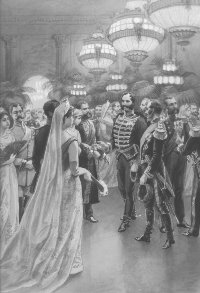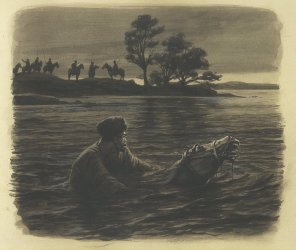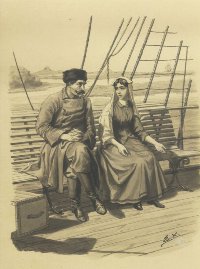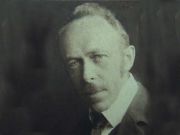The Danish Jules Verne society: Newsletter Nr.
4 (03.03.08)
A few years ago a well known Danish auctioneer offered a collection of original drawings by the Danish artist Emil Krause for sale. The auctioneers described the drawings as illustrations intended for the Jules Verne´s novel “Michel Strogoff” (“Czarens Kurér”).
Before the auction the drawings were shown at an exhibition The Annual Book Fair in “Forum” in Copenhagen, where I had the opportunity to see part of the drawings. The drawings were signed “E.K.-96” (for Emil Krause 1896). They were undoubtedly illustrations for “Michel Strogoff”, but the auctioneers had no information on which edition of Jules Verne´s novel they were intended for. In fact they asked me to identify the book for them! As there is no Danish edition of “Michel Strogoff” from 1896 or the closest following years, I was unable to answer their question. Luckily I was able to purchase the drawings at the following auction. The collection consisted in 36 drawings. They were not of the same size but some of them showed signs of having been cut in the margins. Many of them had numbers written with pencil in the margins. Some of these numbers were cut in half by the reduction of the margins. The numbers were obviously intended as an order in which the drawings should illustrate the book. By comparison with the text the numbers gives a correct order for the illustrations.
The style of the drawings is naturalistic with a great care for the many details. It shows an artist who knows his handicraft. These are obviously not his first attempts as a black-and-white artist. The artist brings furthermore a dramatic life to some of the scenes described by the drawings – thus revealing a capability to familiarize himself with Jules Verne´s text. The scenes in some of the drawings seemed rather well known and the characters similar to the French originals. A comparison with the Hetzel edition revealed that approximately half of the illustrations had a close resemblence with Jules Férat´s original illustrations. The composition in these were more or less like the Férat-illustrations. In my opinion Krause has added more life to the sceneries and figures – where Férat is rather rigid in his style. But it is beyond doubt that Emil Krause had a book with the Frensh illustrations near at hand when he created his work. Krause: 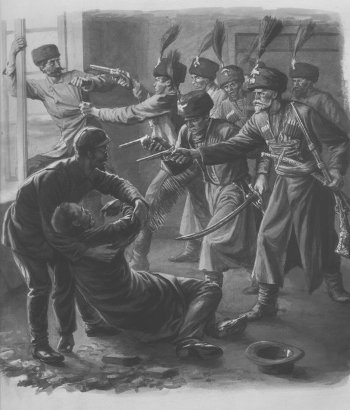 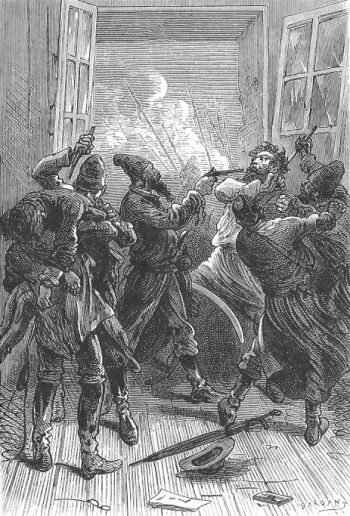 The other half were new illustrations with no model in the French edition. They were illustrations to the text – which was easy to identify. It is obvious that the illustrations are not a complete work as there are no illustrations for the last chapters of the book.
Axel Emil Krause lived from 1871 to 1945. He was a painter as well as a lithographic artist and today he is appreciated for his paintings. He was educated at the Academy of Fine Arts in Copenhagen from 1889 to 1895.
In 1896 at the age of 25 he had recently left the academy after finishing his education. The drawings for “Michel Strogoff” were appearently the work of a young artist with a distinct talent. 4 years later he makes the illustrations for another Jules Verne novel “L´Île Mystérieuse”, published by the Danish publishing company Jespersen in the year 1900. This time only 4 illustrations were used. Why did Krause draw the 36 (or more?) illustrations for “Michel Strogoff”
in 1896?
There is room for theories: Maybe he made the drawings as a way to present himself and his skill hoping to get work for the publishers. But why then so many drawings and not just a few? Maybe it was a work ordered by a publisher who had to abandon the project. That could explain the missing last pictures. Another explanation for the missing illustrations could be, that they have existed but have been separated from the present collection. I hope that he was paid for the great work and the many hours he must have spent to make the drawings. They are not in any way sketchy – they are ready for the printer. I think we are lucky to have these interesting illustrations today – and in my opinion they deserve to be known by Jules Verne readers as well as art lovers. All Emil Krauses illustrations can be seen on The
36 Krause-drawings
Henrik Wilfred Christensen 2/08.
|
